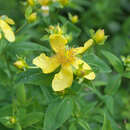Comments
provided by eFloras
Hypericum ascyron is a highly variable species or species complex with a very wide distribution. Although several variants have been recognized as varieties or even species, the variation appears to be nearly continuous.
The most frequently distinguished taxon has been Hypericum gebleri, which most Russian authors have recognized, as it occurs throughout most of S Siberia along with larger-flowered, less-branched forms and is present alone in Kamchatka, the Kurile Islands, and Sakhalin. On the other hand, Chinese authors have tended to include it in H. ascyron, because intermediate forms occur in the north. The North American population, too, was recognized early at species level but none of the characters said to distinguish it appears to be constant.
Under these circumstances, it seems best to distinguish the N Asian Hypericum gebleri and the North American H. pyramidatum Aiton as subspecies (see Robson, Bull. Nat. Hist. Mus. Lond. (Bot.) 31: 37-88. 2001). It seems impossible to recognize the long-styled (mainly large-flowered and northern) plants and the narrow-fruited, C Chinese ones (respectively var. longistylum and var. giraldii [var. hupehense]) as distinct taxa, as both represent extremes of continuous variation. Likewise, the narrow-leaved, small-flowered form from S China (misidentified as var. angustifolium Y. Kimura) merges with more typical forms.
- license
- cc-by-nc-sa-3.0
- copyright
- Missouri Botanical Garden, 4344 Shaw Boulevard, St. Louis, MO, 63110 USA
Description
provided by eFloras
Herbs, perennial, 0.5-1.3(-2) m tall, erect or sometimes ascending from short creeping base; stems single or few, cespitose, unbranched or branched above or nearly throughout. Stems 4-angled when young, becoming 4-lined or occasionally internodes 2-lined below. Leaves sessile; blade lanceolate or ± narrowly ovate or oblong or elliptic to oblong-linear or oblanceolate, (3-)4-9.7(-12) × (0.4-)0.7-3.5(-4) cm, thickly papery, abaxially rather paler but not glaucous; laminar glands dense, unequal dots or short streaks; intramarginal glands dense; main lateral veins 4-7-paired, tertiary reticulation dense, often obscure; base cuneate to cordate-amplexicaul, apex acute to subapiculate or obtuse (or lowermost rarely rounded). Inflorescence 1- to ca. 35-flowered from 1-5 nodes, the whole nearly flat-topped to narrowly pyramidal, sometimes with flowering branches from up to 4 nodes below; bracts and bracteoles leaflike but smaller and often broader, more rarely linear-lanceolate and deciduous. Flowers 3-7(-8) cm in diam., stellate with petals spreading to reflexed; buds broadly to narrowly ovoid, apex rounded to subacute. Sepals free, erect, oblong to elliptic or ovate to ovate-lanceolate or obovate, subequal to unequal, the outer ones sometimes leaflike, (0.3-)0.5-1.5 cm × (1.5-)2-7(-10) mm; laminar glands lines, distally interrupted to streaks; marginal glands spaced, small, margin entire, apex rounded to obtuse or rarely subacuminate to acute; veins 11-17. Petals bright (to ?golden) yellow, sometimes tinged red in bud, obovate or oblong-obovate to oblanceolate, often somewhat spatulate to subunguiculate, strongly curved to nearly straight, 1.4-4.1 × 0.5-2 cm, 2-3 × as long as sepals or shorter when sepals leaflike; laminar glands lines to short streaks; marginal glands absent; margin entire, apex rounded or obtuse to rarely acute to acuminate; apiculus short and rounded or absent. Stamen fascicles (?4 or)5, each with ca. 30 stamens, longest 0.9-2.5 cm, 0.4-0.67 × as long as petals. Ovary broadly ovoid to narrowly ovoid-pyramidal or ellipsoid; styles (4 or)5, 2.5-15 mm, 0.5-2 × as long as ovary, free or up to 0.8 coherent or connate; stigmas broadly capitate to funnel-shaped. Capsule broadly to narrowly ovoid or ovoid-pyramidal or rarely narrowly cylindric, 0.9-2.2(-3) cm × 5-13 mm, 2-3 × as long as sepals, apex obtuse to rounded. Seeds dark red-brown to yellow-brown, 1-1.5 mm, deeply carinate or narrowly winged, sometimes with slight terminal expansion; testa densely shallowly linear-reticulate. Fl. Jun-Sep, fr. Aug-Oct. 2n = 16, 18, 20, 22 (usually 18).
- license
- cc-by-nc-sa-3.0
- copyright
- Missouri Botanical Garden, 4344 Shaw Boulevard, St. Louis, MO, 63110 USA
Distribution
provided by eFloras
Throughout China except Xizang [Japan, Korea, Mongolia, Russia (Altai to Kamchatka and Kurile Islands, Sakhalin), Vietnam; North America (E Canada, NE United States)].
- license
- cc-by-nc-sa-3.0
- copyright
- Missouri Botanical Garden, 4344 Shaw Boulevard, St. Louis, MO, 63110 USA
Habitat
provided by eFloras
Moist to dry meadows, grassy or rocky slopes, sometimes in forests or among scrub, streamsides and river banks; sea level to 2800(-3600) m.
- license
- cc-by-nc-sa-3.0
- copyright
- Missouri Botanical Garden, 4344 Shaw Boulevard, St. Louis, MO, 63110 USA
Hypericum ascyron: Brief Summary
provided by wikipedia EN
Hypericum ascyron, the great St. Johnswort or giant St. John's wort is a flowering plant in the family Hypericaceae.
- license
- cc-by-sa-3.0
- copyright
- Wikipedia authors and editors

